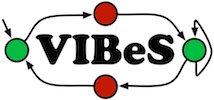

The different kinds of transitions systems supported by VIBeS may be defined by redefining one of the following abstract classes and by implementing its define() method:
import be.unamur.transitionsystem.dsl.*;
public class MyLTS extends LabelledTransitionSystemDefinition{
public MyLTS(){
super();
}
@Override
protected void define() {
initial("initial");
from("initial").action("act1").to("s1");
from("s1").action("doX").to("s2");
from("s1").action("doXY").to("s3");
from("s2").action("doY").to("s3");
from("s3").action("exit").to("initial");
}
public static void main(String[] args){
MyLTS def = new MyLTS();
LabelledTransitionSystem lts = def.getTransitionSystem();
}
}Feature expressions are boolean expressions defined over features. In VIBeS, feature expressions have to respect the following grammar:
FEXPRESSION:
'true'
| 'false'
| FEATURENAME
| '!' FEXPRESSION
| FEXPRESSION '&&' FEXPRESSION
| FEXPRESSION '||' FEXPRESSION
| '(' FEXPRESSION ')'
FEATURENAME:
LETTER (LETTER | DIGIT)*
LETTER:
'A'..'Z' | 'a'..'z' | '_'
DIGIT:
'0'..'9'The operators priority is defined as following : parenthesis ('(' FEXPRESSION ')') > not ('!') > and ('&&'), or ('||')
Various transition systems may be loaded/saved in XML files.
import static be.unamur.transitionsystem.dsl.TransitionSystemXmlLoaders.*;
import static be.unamur.transitionsystem.dsl.TransitionSystemXmlPrinter.*;
public Main{
public static void main(String[] args){
LabelledTransitionSystem lts = loadLabelledTransitionSystem("myLTS.xml");
// [...]
print(lts, "otherLTS.xml");
}
}The class ConfiguredMutagen allows to easilly generate mutants using a configuration file specifying the mutation operators configuration:
import static be.unamur.transitionsystem.dsl.TransitionSystemXmlLoaders.*;
import static be.unamur.transitionsystem.dsl.test.mutation.ConfiguredMutagen.*;
public Main{
public static void main(String[] args){
LabelledTransitionSystem lts = new MyLTS().getTransitionSystem();
// Loads the mutation operators configuration
// E.g., ennumerative mutants generation
configure("operatorsConfig.xml")
.outputDir("mutants/") // Generates mutants in the given folder
.mutate(lts);
// E.g., FMM generation
configure("operatorsConfig.xml")
.ftsMutant("fmm.fts") // Generates FMM's FTS with given name
.tvlMutant("fmm.tvl") // Generates FMM's FD in TVL format
.mutate(lts);
// E.g., ennumerative and FMM generation (will generate the same mutants)
configure("operatorsConfig.xml")
.outputDir("mutants/") // Generates mutants in the given folder
.ftsMutant("fmm.fts") // Generates FMM's FTS with given name
.tvlMutant("fmm.tvl") // Generates FMM's FD in TVL format
.mutate(lts);
}
}Here is a exemple of configuration file (in XML):
<?xml version="1.0" encoding="UTF-8"?>
<config>
<mutantsSize>200</mutantsSize> <!-- Default mutant size (may be redefined) -->
<!-- Default selection strategies for each operator (may be redefined) -->
<actionSelection>be.unamur.transitionsystem.test.mutation.RandomSelectionStrategy</actionSelection>
<stateSelection>be.unamur.transitionsystem.test.mutation.RandomSelectionStrategy</stateSelection>
<transitionSelection>be.unamur.transitionsystem.test.mutation.RandomSelectionStrategy</transitionSelection>
<unique>true</unique> <!-- Default uniqueness of each mutant (may be redefined) -->
<!-- Operators -->
<operators>
<operator>
<class>be.unamur.transitionsystem.test.mutation.ActionExchange</class>
</operator>
<operator>
<class>be.unamur.transitionsystem.test.mutation.ActionMissing</class>
</operator>
<operator>
<class>be.unamur.transitionsystem.test.mutation.StateMissing</class>
</operator>
<operator>
<class>be.unamur.transitionsystem.test.mutation.TransitionAdd</class>
</operator>
<operator>
<class>be.unamur.transitionsystem.test.mutation.TransitionDestinationExchange</class>
</operator>
<operator>
<class>be.unamur.transitionsystem.test.mutation.TransitionMissing</class>
</operator>
<operator>
<class>be.unamur.transitionsystem.test.mutation.WrongInitialState</class>
<mutantsSize>100</mutantsSize>
<actionSelection>be.unamur.transitionsystem.test.mutation.RandomSelectionStrategy</actionSelection>
<stateSelection>be.unamur.transitionsystem.test.mutation.RandomSelectionStrategy</stateSelection>
<transitionSelection>be.unamur.transitionsystem.test.mutation.RandomSelectionStrategy</transitionSelection>
<unique>false</unique>
</operator>
</operators>
</config>It is also possible to configure a particular mutation operator for a given transition system using the Mutagen class:
import static be.unamur.transitionsystem.dsl.TransitionSystemXmlLoaders.*;
import static be.unamur.transitionsystem.dsl.test.mutation.Mutagen.*;
import be.unamur.transitionsystem.test.mutation.*;
public Main{
public static void main(String[] args){
LabelledTransitionSystem lts = new MyLTS().getTransitionSystem();
FeaturedTransitionSystem fts = new F
// Initialise the operatro for the given transition system
MutationOperator op = transitionMissing(lts)
.transitionSelectionStrategy(new RandomSelectionStrategy())
.done();
// Apply the operator
op.apply();
// Get the mutant transition system (enumerative version)
LabelledTransitionSystem mutant = (LabelledTransitionSystem) op.result();
// Enrich the FMM's FTS with the new mutant
op.transpose(ftsFMM);
// Get the feature ID used in the FMM's FTS (should be added to the used feature diagram)
String mutantFeatureId = op.getFeatureId();
}
}